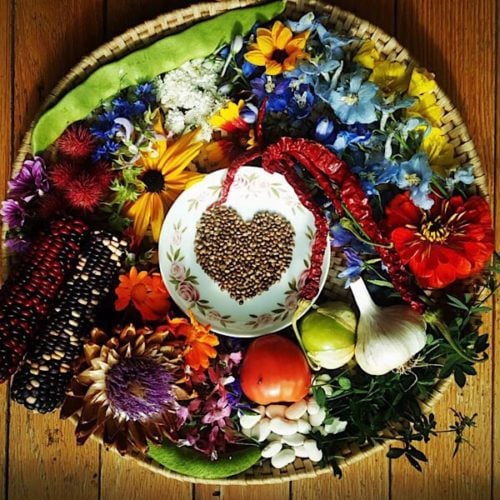This is our farm column from farmer Casey O’Neill. O’Neill is the owner operator of HappyDay Farms north of Laytonville, and a long time advocate for the cannabis community in Mendocino Co; more of his writing can be found here. The opinions expressed in this column are those of the writer. If you would like to submit a letter to the editor feel free to write to [email protected].
I’m full steam with starting seeds for late winter and spring crops. In the last couple weeks I sowed salad mixes, turnips, radishes, scallions, onions, shallots, kales, collards, broccoli, cabbage and cauliflower. Each week my goal is to sow seeds for everything that I think I can sell in a week, so that there is a steady supply coming in to fill the CSA, market table and farmstand.
Using the new trays for the paper pot transplanter, I’m able to sow 264 seeds to each tray, which is a dramatic increase from the 72 cell trays we’ve tended to use. For the large brassica (cooking greens, cabbages etc) I’m still using the 72’s, and the plants will be potted up to 3” pots to size up before planting out into their final homes.
As we arrive in the beginning of February I’m just about finished with winter plantings inside the tunnels. This coming week the remaining five rows will be transplanted with beets, lettuce, asian greens salad mix and scallions, and then it will be time to roll into the outdoor plantings.
The new transplanter needs the soil to be very well prepped, soft and free of detritus. The main cannabis terraces in our garden have long since developed into rich and beautiful soil, and getting going this early in the year means that I can pull a full round of harvest out of a bed before it’s time for cannabis planting.
I don’t always manage to get going so early with plantings, especially in the cannabis terraces which are usually under heavy cover crop. This year is an exception because the pigs tore up the beds so badly in the fall that we got shit germination on the cover crop. I put down straw mulch to protect the soil, but the lack of cover crop makes early bed prep super easy.
In the past we tended to do a big prep day in each garden to mow all the cover crop with the flail mower, put down compost and amendments, run the power harrow, broadfork and cover with old dep tarp to hasten the decomposition of the cover crop. The power harrow mixes the chopped cover crop and compost into the top inch of the soil surface, getting good soil contact without disturbing the deeper soil profiles.
This year, my goal is to prep one or two terraces each week, keeping up with my transplanting and not taking on a huge push. Without the heavy cover crop I can use the battery operated tilther to mix the compost into the upper soil layer, so I don’t have to get out the BCS and use the big implements. I’ve been working to break large projects into smaller, bite-size jobs to stop them from being so overwhelming and avoid overwork.
We’re using a basic germination chamber made from an old refrigerator and a single-tray heat mat that takes 17 watts to run. Low energy, low-tech, low cost, consistent germination so long as I’m on time taking the trays out so that the starts don’t get leggy and pale. Managing the germ chamber is another one of those little tasks that I have to make time to do every day, just like watering the starts in the propagation house, feeding the livestock and checking the water systems.
With the big hoophouses just about fully planted, I’ll be shifting to the terraces for the next rounds. In the past we’ve built low tunnels from ½” EMT metal conduit bent into hoops that cover a 42” bed surface. A stake at either end holds the baling wire purlin which wraps around each hoop as it goes down the row, securing the tunnel. Frost blanket goes over the top, the thicker AG30 works well because it doesn’t rip.
This year I’m shifting some of the crops to a lower intensity method; after planting, I’ll lay the insect netting flat across the bed, protecting the tender crops from birds and other pests. I’ll also deploy the frost blanket on the North side of the rows, ready to pull it over the top and anchor it for cold spells.
Frost blanket is awesome for keeping things warm but doesn’t allow for much air movement or water to flow through it, so it’s not ideal for sunny days because it gets too hot underneath. Drip irrigation has been somewhat effective for early spring greens, but with the mechanical greens harvester it makes less sense to have the drip down, so I’ll be deploying wobbler overhead sprinklers, which will need the frost blanket off to be most effective.
Each year I make refinements as new equipment and information become available. There is a tremendous wealth of possibility being created by small farmers, a renaissance in tools and knowledge that makes for more efficient, effective operations. As the old saying goes, hope springs eternal! As always, much love and great success to you on your journey!




